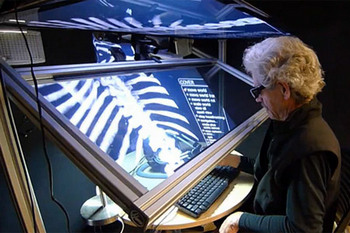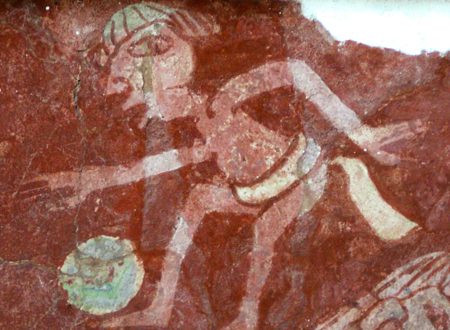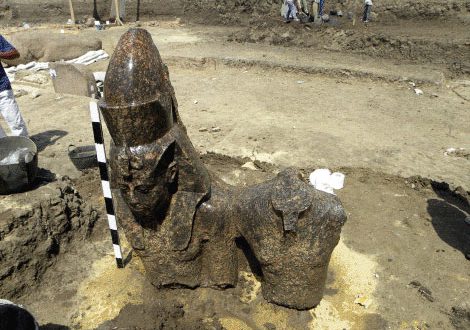 Anyone who has visited the ancient ruins of great civilizations can appreciate the difficulty of visualizing the buildings at their peak. Today’s visitor to the British Museum can see structures of the Aztecs, thanks to one professor’s research into the ancient architecture that served as the center stage of Aztec ceremonial life, combined with an ultra-modern electronic digital modeling process.
Anyone who has visited the ancient ruins of great civilizations can appreciate the difficulty of visualizing the buildings at their peak. Today’s visitor to the British Museum can see structures of the Aztecs, thanks to one professor’s research into the ancient architecture that served as the center stage of Aztec ceremonial life, combined with an ultra-modern electronic digital modeling process.
Antonio Serrato-Combe, professor of architecture at the University of Utah, has spent decades bringing the ancient structures of the Aztecs into focus. His work is now the basis for a new British Museum exhibition ‘Moctezuma: Aztec Ruler,’ exploring the power and empire of the last elected Aztec Emperor, Moctezuma II.
Moctezuma – who reigned from 1502 to 1520 – was a ruler of semi-mythical status. He inherited and then consolidated Aztec control over a politically complex empire that by the early 16th century stretched from the shores of Pacific to the Gulf of Mexico. His major accomplishment was the construction of the Templo Mayor Precinct in Tenochtitlan, Mexico. The temple was called the huey teocalli in the Nahuatl language and dedicated simultaneously to two gods, Huitzilopochtli, god of war and Tlaloc, god of rain and agriculture. The Templo Mayor complex was the epicenter for Aztec ceremonial life and served as the setting for colorful displays of highly energized rituals depicting the relationships between social groups and humans and their gods.
On 14 November 1521, Cortes seized the emperor Moctezuma II and ordered the destruction of all the religious relics of the Aztecs. He ordered a Catholic cross placed on top of the Templo Mayor. Desecration of the Temple did not stop there. The conquistador Pedro de Alvarado then launched an attack against the Aztecs in the Sacred Templo Mayor Precinct while they celebrated a religious festival. Unarmed and trapped within the walls of the complex, an estimated 8,000 to 10,000 Aztec nobles were killed. The Aztecs in took their revenge, slaughtering 68 conquistadors in the Templo Mayor; the sacrificed Spaniards were flayed and their faces – with beards attached – were tanned and sent to allied towns, both to solicit assistance and to warn against betraying the alliance.


Professor Serrato-Combe’s digital model of the ‘Great Temple’ complex, dedicated simultaneously to two gods, Huitzilopochtli, god of war and Tlaloc, god of rain and agriculture.
(Images courtesy the University of Utah)
The question of what the Aztec Templo Mayor Precinct looked like has piqued the curiosity of many, including Professor Serrato-Combe. For more than two decades, he has been trying to solve the mystery on how the capital of the Aztecs looked by using the technology and tools of architecture. His book, The Aztec Templo Mayor: A Visualization was published in 2002 by the University of Utah Press.
“The Aztec capital was a thriving metropolis planned and built according to principles that not only understood and applied critical environmental issues, but added holistic concepts as well,” explains Serrato-Combe. “The Aztecs did not compartmentalize the arts. The final result was a unique combination of architecture, sculpture, painting, costume, wall and sand painting, pottery, masks, amulets, all into one expression. I envy those individuals who had the opportunity to experience those environments.”
Combe’s research and visualizations are centered on historic and archaeological studies conducted on-site in Mexico City, in conjunction with extensive research on Mesoamerican Manuscripts. The research itself took more than two decades, due to the complexity and diverse nature of the historic and archaeological record.
More involved than the research however, was the question of how to visualize the discoveries. A self-proclaimed computer geek, it was at the suggestion of a student that Combe combined his two passions of research and computer graphics into an illustrated book. He said, “One day, after one of my history classes here at the University of Utah, one of my students remarked, ‘since you know so much about Pre-Columbian architecture and you also seem to be a computer geek, why don’t you combine both disciplines and come up with a book that uses digital tools to illustrate the past?” The rest is history.
 Through his project, Combe has become the authority at the University of Utah on digital visualization techniques and now teaches architecture students the basics of an integral tool in architecture. “Digital tools in architecture are unique in that they provide a communication channel where a student does or proposes something and the computer responds,” he says. “The conversation between student and machine triggers a variety of actions that eventually make the academic experience more exciting and fruitful.”
Through his project, Combe has become the authority at the University of Utah on digital visualization techniques and now teaches architecture students the basics of an integral tool in architecture. “Digital tools in architecture are unique in that they provide a communication channel where a student does or proposes something and the computer responds,” he says. “The conversation between student and machine triggers a variety of actions that eventually make the academic experience more exciting and fruitful.”
The digital modeling process for the exhibit this month began by simulating structures based on historical accounts and current archaeological data including satellite imagery. Once a highly complex drawing-layer system was set, a solid model was constructed that determined the overall dimensions for the most important structures that archaeologists have been able to uncover to date. Some sections, including the base of the largest temple within the precinct, are still visible today.



